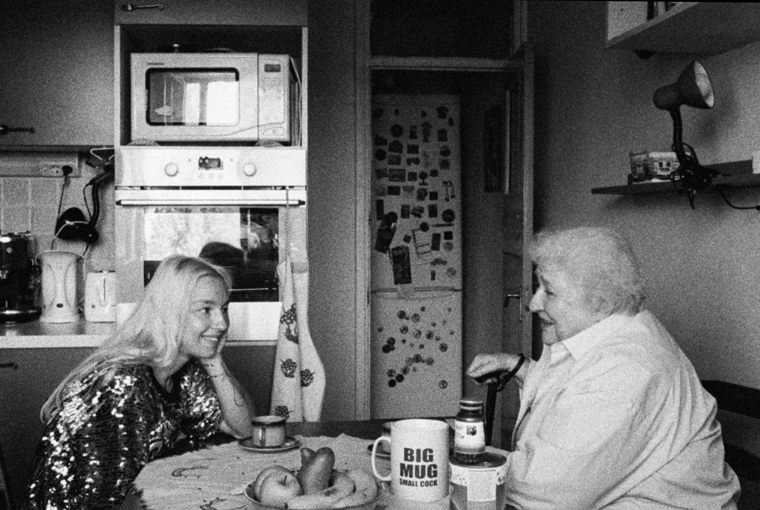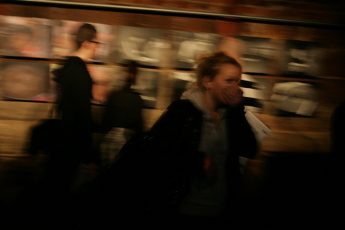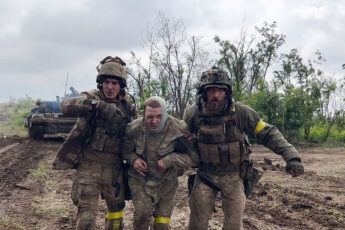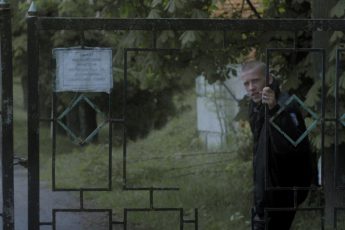Is the Multiverse Where Originality Can Find Shelter?
Radu Jude’s Do Not Expect Too Much from the End of the World (Nu aștepta prea mult de la sfârșitul lumii, 2023)
Vol. 139 (November 2023) by Anastasia Eleftheriou
In times of desperation about originality in cinema, a cinephile can always count on the ideas of Radu Jude. His new film Do Not Expect Too Much from the End of the World that premiered at the 2023 Locarno Film Festival will not disappoint those who expect “too much” of the renowned Berlin Golden Bear winner and post-Romanian New Wave director. In his film, which he aptly describes as a “collage film” but is more of a film of forms, archive images, colors and ideas filled with cynical humor and daring writing, Jude presents a series of diverse and shifting tableaux: different faces of the main character, different eras in Romanian history, and a variety of ways of filming and editing (the film radically shifts form halfway through).
In contemporary Bucharest, shot in B&W, Angela (Ilinca Manolache) works overtime for an audiovisual production company. She navigates the streets tirelessly, unpaid and shamelessly exploited in the pursuit of her job. The ongoing project assigned to Angela’s company by a prominent Austrian enterprise entails her driving across Bucharest to film disabled individuals – victims of severe workplace accidents – within the confines of their homes using her iPhone. The subjects have to “alert” other workers to be careful and strictly follow all regulations in order to avoid work accidents, while never alluding to the fact that they were all working overtime when their respective accidents happened. The most convincing “candidate” will be included in a film promoting the company and rewarded 1000 euros. As Angela tirelessly navigates the relentless hustle of modern Bucharest, a city depicted in its stark, violent, and sexist contemporary facets, she is denied any respite. Unable to negotiate time off or even steal a moment for a short nap, one can’t shake off the chilling parallel with Uber drivers. The fear looms large: will this young lady too succumb to exhaustion and have an accident?
The only world Angela can find comfort in is the one that she has built for herself: an avatar named ‘Bobiță’ on Tik Tok embodying a toxic male conservative persona reminiscent of Andrew Tate. Angela’s videos as Bobiță push the boundaries of vulgarity and repulsion. By offering an alternative universe and identity to her miserable life, Angela opts for criticism through caricature, as she openly states in the film. What might seem like a brilliant narrative idea for Jude, is yet another manifestation of the popular idea that life is often much more interesting than fiction.
As it turns out, Bobiță is Ilinca Manolache’s social media avatar outside of the film’s universe too. When Radu Jude approached her to act in his new film, he made one condition: she had to bring her avatar along! Whether Bobiță’s deeply provocative and offensive on-screen performances were scripted by her or by Jude remains a mystery. However, Manolache’s real-life avatar is as provocative as her “fictional” one, full of deadpan humor and sharp social commentary. With her avatar, Manolache reveals how the creation of multiple identities is intricately entwined with the cruel world we live in. But instead of embodying escapism, as some might expect from the shift to an alternative persona, Manolache’s sarcastic and provocative Bobiță is bursting with creativity and sharpness, with videos that are always contextualized relative to specific moments taking place in real life. In that sense, the unhealthy persona is nothing more but a sane reaction of an exploited modern woman.
Radu Jude alludes to different forms of technology throughout the film – be it livestreams, Tik Tok, or the ability to “crop and make things look as we like now that we can film on 8K”, as one of the video directors of the Romanian company tells his Austrian boss while on a zoom call. The film also burrows into the effects that remote Zoom meetings have on the dynamics of work, especially in the context of Austrian companies exploiting Romanian businesses, which in turn exploit Romanian employees. The technological platforms presented in the film serve as modern-day theater stages. However, unlike Bobiță’s emancipatory journey, in which multiple identities are a form of liberation, here, the portrayal takes a darker turn and technophobic element. Coerced into assuming different existences, individuals appear trapped in roles that are being imposed upon them.
The concept of the multiverse, once a simple storytelling device, has been turned into a strategic tool of the entertainment industry, allowing major companies to rejuvenate beloved characters. This trend resonates deeply with today’s youth, who are accustomed to crafting various identities on social media platforms. Our current cultural landscape is saturated with sequels, prequels, and reboots, making us live in what Stephanie Burt has called a “Multiverse moment.”1 In this era dominated by recycled content, multiverses become essential because they enable us to explore limitless possibilities. Some argue that the rise of the multiverse mirrors our necessity to juggle multiple identities. As we seamlessly transition between Instagram, Slack, and family group chats, or navigate diverse roles at work, home, and parent-teacher meetings, the multiverse concept allows us to embrace the complexity of our identities.
Angela’s double fictional persona, with clever “meta” nods to her real-life identity, becomes even more intriguing as Radu Jude’s film seamlessly oscillates between her story and scenes from an obscure 1980s Romanian film titled Angela Moves On (Angela merge mai departe, dir. Lucian Bratu). In this film that very few people would recognize even in Romania (let alone abroad), a female taxi driver roams the streets of 1980s Bucharest while a Hungarian young man tries to convince her into entering into a romantic relationship with him. The film is shown in color, as opposed to “today’s story”, which as the director said during a Q&A of his film in Paris, was edited in B&W for a very simple reason: had they kept the color, the contrast between the two eras would not have been sufficiently evident. The 1980s taxi driver is also called Angela (Dorina Lazar). As this multiverse counterpart is driving around the city, she does not come across as being subject to exploitation nor even exhaustion. In fact, she even seems quite safe (even though the country was ruled by Ceaușescu at the time). In this portrayal, Bucharest is humanized, inviting viewers to contemplate Romania’s recent history, and prompting them to challenge preconceived notions about concepts of the West such as Progress and Hope. The cherry on top of this frantic multiverse ride is when 1980s Angela shows up as an old woman playing the mother of one of the disabled candidates that modern Angela visits for her film. “How funny, my name is Angela too”, she says while introducing herself to the young lady, with all of the narratives that Jude has developed up to this point seemingly struggling to meet in this single moment. As a matter of fact, Angela’s old husband is actually Hungarian! Only when his gentle character jumps out of Angela the cab driver’s taxi to meet her again, 40 years later, at home, as an old husband and father of a disabled man, he goes sort of nuts. This is the type of nuttiness that manifests in never being sober, and in his being rather obsessed with his Hungarian identity that he had to compromise after spending a lifetime in Bucharest. He does ponder upon the life he could have lived in that parallel universe in which he would have gone back to Hungary!
Halfway through the film, Radu Jude decides to radically change his narrative approach. By focusing on the shoot of the so-called promotional video, he tries to pick up the pieces of this multiverse narrative and fit them into one sole story, where every character would find their place. This does justice to his film. As a matter of fact, we can’t go on building universes and identities forever, leaving all possibilities and options open, because that entails the risk of escapism and the concurrent loss of any true meaning in life. So in the second part of the film, Jude gets to the right version of his story, where he remains till the end: a candidate has been chosen among the disabled victims of the work accidents and now the logistical part of shooting the promotional video has to be taken care of. In a comic but merciless sequence, we get to see how exhausting filmmaking can be, what it means to produce images and manipulate viewers, what it means to “use” people as subjects to serve a violent capitalistic world, and how we are all part of the problem when producing and consuming these images. (This part, along with other clear visual games and references, brings back the old JLG’s spirit.) The staff of the Romanian company seem totally alienated by the reality they are operating within, yet they show an outstanding lack of morality while trying to do their job in fear of the Austrian side’s demands. Modernday Angela’s reaction is again to produce recurrent Bobiță posts that instill humor and a “distancing effect”. What sounds violent is not more or less violent than what is taking place in front of our eyes, so she opts for a post where Bobiță defends Putin and supports the bombings in Ukraine.
During the Parisian premiere of Do Not Expect Too Much from the End of the World at the Centre Pompidou, a young woman inquired about the director’s choice of humor and references that might not resonate with non-Romanian viewers. Such a question was very revealing about both the film and the audience, and a solid rock to stand on for discussing Jude’s new cinematic experiment. Jude calmly replied that he has spent his life watching American and French films in which, obviously, a part of the dialogs and references would escape a foreign viewer. However, he believes that the world his film is talking about is pretty much the same for most viewers on the globe. For the rest, he says, “it’s the force of small cultures, they can keep their own worlds to themselves”. Clearly, the audience member’s remark came from another universe, in which experiences cannot be shared unless they take place within the confines of a homogeneous culture. Will we ever be able to reconcile our different identities without having to converge, as in Hollywood, or even as in homogenized artsy cinema from the CNC, along the one true path? Radu Jude has shown that it is possible.
References
- 1.Stephanie Burt, Is the Multiverse Where Originality Goes to Die?’’, New Yorker, 31 October 2022.




Leave a Comment